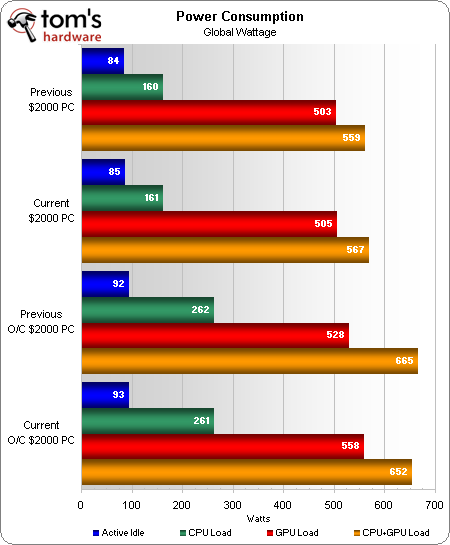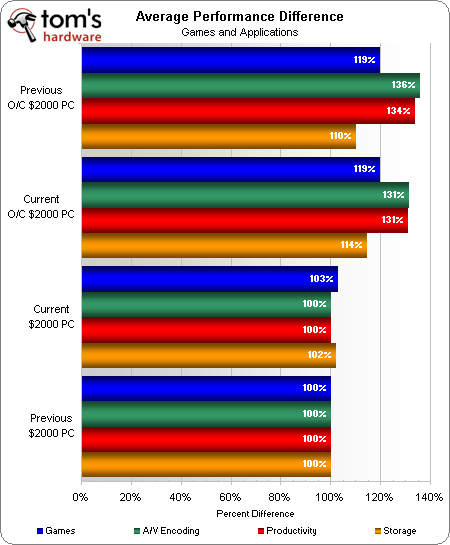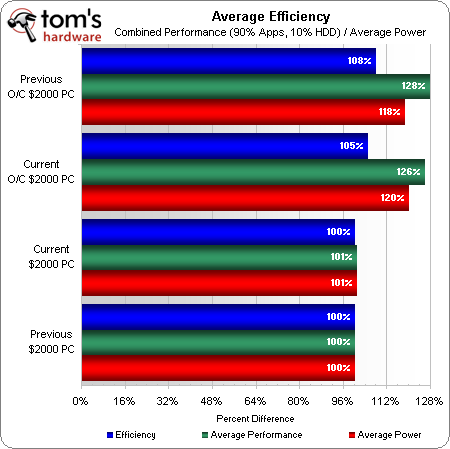System Builder Marathon, June 2011: $2000 Performance PC
Power, Heat, And Efficiency
Our previous build consumed slightly less energy, though this can be affected by small things like GPU temperature.
The new machine’s graphics cards ran a little warmer at stock speed, even though they’re the same card model. We’re going to blame Lian-Li’s sideways hard drive cage for the difference, since it partially blocks airflow from the lower intake fan to the cards, and note that the cards ran cool enough anyway.
Even at full overclock, we never GPU fan speeds above 50%.
While a higher overclock benefited the previous build in CPU-limited applications, newer drivers appeared to help the current build lead at high settings in a few games. The end result is nearly-identical overall gaming performance, in spite of the former build’s small leads in A/V encoding and productivity.
Slightly higher graphics power consumption and slightly lower overall performance lead our current build to its fall in average efficiency. The overclocked configuration still beats the base frequencies however, since performance increased at a greater rate than power consumption.
Current page: Power, Heat, And Efficiency
Prev Page Benchmark Results: Productivity Next Page Value ConclusionGet Tom's Hardware's best news and in-depth reviews, straight to your inbox.
-
regenon I gess u wanted to say:Reply
A pair of Radeon HD 6950s beats a pair of GeForce GTX 570s at our 2560x1600 target resolution, and the HD 6970 is even faster. -
Tamz_msc Finally you made a decent choice regarding the case. I could not believe you went with the Antec 300s on previous builds of this category.Reply -
buzznut I agree, though some may care less for what's on the outside I can't see putting together a $2000 PC with a 50 dolla case.Reply -
Yes, I am pleased to see a classy looking Lian Li case being used and not one of those gargoyle-inspired transformer-looking abominations that appeal only to google-eyed children and pimply-faced teenagers. That an adult might actually purchase that sort of monstrosity damped my hope for the future of the supposedly mature population of this world!Reply
-
hmp_goose So it's now considered "safe" to RAID 0 SSDs? I thought Tom's once had a big "here be dragons" label for that practice …Reply -
compton I too like the upgrade to a Lian Li. I didn't have a problem with the SBM method of fitting into a tightly constrained budget - but it's still good to see an attractive system as well as impressive performance. If someone is building a $2000 system, they can pony up a couple extra bucks for a better case. The System Builder Marathon is one of the best things going.Reply -
dragonsqrrl Again, another great high-end build (very similar to previous build), and my only real complaint (albeit a small one) from the last $2000 system was also addressed, the case.Reply
Are you guys satisfied with your decision to go with a higher-end case? Have you noticed any tangible benefits? For example, lower system temps, better build quality, better cable management, more interior room to work, additional features, etc...? -
whysobluepandabear Todd SauveYes, I am pleased to see a classy looking Lian Li case being used and not one of those gargoyle-inspired transformer-looking abominations that appeal only to google-eyed children and pimply-faced teenagers. That an adult might actually purchase that sort of monstrosity damped my hope for the future of the supposedly mature population of this world!Reply
You give vivid details describing children and teenagers, but might I add something for the adults? Something like: "That a wrinkly, weaker and deteriorating adult might actually purchase". Something along those lines - we must make those adults look like old fuddy-duddies, whom are at the brink of a midlife crisis any moment now!





